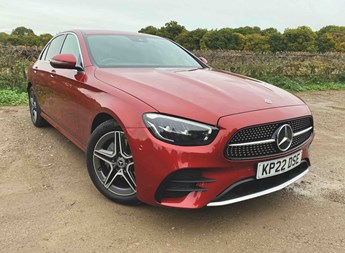We use cookies to ensure that we give you the best experience on our website. If you continue without changing your settings, we will assume that you are happy to receive all cookies on the Business Car website. However, if you would like to, you can change your cookies at any time

The start point for the best source of fleet information |
Model update: Mercedes-Benz E300e
Date: 30 March 2023 | Author: Martyn Collins

|
|
||||||||||||||||||||||||||
The advent of Covid didn't mean that the release of the facelifted E-Class in the UK passed us by, but only now have we had the chance to drive what is surely going to be the best-selling model (E300e), in the likely most popular trim - AMG Line.
Outside, you'll spot the latest E-Class by the revised front and rear bumper designs, new front grilles, redesigned front and rear lights, and for saloon models, a new boot lid.
Overall, these changes are subtle, but give Mercedes' mid-size executive challenger a sharper look that's more modern. However, when compared to its sister car, the all-electric EQE, the current E-Class's angular design makes it look like a car from another age.
Inside, the biggest change to the E-Class's quality interior is the adoption of the two 10.3in digital displays for the instruments and infotainment. The new screens are neatly integrated into the E300e's dashboard and are complimented by the classy dark ash wood trim of our test car.
Rear legroom is no better than average, and the curve of the roofline means the tallest will find their heads brushing the headlining. The most noticeable interior compromise of having the extra hybrid battery is the drop in boot space (140 litres in fact). Although still useful, the boot now totals 400 litres and is practically shaped.
The only giveaway that the E300e is a bit different from standard is the badging and the extra filler cap on the left on the outside.
The E300e is powered by a 211hp, 2.0-litre petrol turbo engine combined with a 13.5kWh battery and 122hp electric motor, equalling an impressive 320hp. But the performance figures aren't what this E-Class is about. While they are impressive, company car drivers are going to be keener on the 12% BIK charge, 35g/km emissions, and an unbelievable 176.6mpg. I say unbelievable, as data from Kee Resources suggests this figure is 39.8mpg in real-world conditions.
Still, Mercedes claims 34 miles on electric power alone. Even in the colder weather when we had this car, the E300e covered roughly 25 miles on EV power during a 200-mile round trip, which was mostly covered on motorways - and it wasn't fully charged when we started the trip.
Being the plug-in hybrid, this E-Class automatically defaults to electric mode from start off, with the engine only being called on at higher speeds or when the battery needs recharging. We didn't notice much difference in Hybrid mode - with 440Nm of torque, the E300e is surprisingly willing from the off and 0-62mph acceleration is completed in 5.7 seconds. Like the smaller C300e, this a refined and comfortable way to cover big miles - but the weight of the battery can make this Mercedes' ride surprisingly wallowy over potholed roads and it is nowhere near as involving to drive as the BMW 530e. Still, on the flip side, the steering has a reasonable amount of feel.
When it comes to charging, the E300e takes an hour and a half to fully charge via a wall box, as this Mercedes is fitted with a 7.2kW on-board charger. Go for the three-pin plug option and the time to charge goes up to five hours.
Like every PHEV, it's worth keeping the battery charged up, in the first instance for the obvious running cost savings. The second being the fact it's noticeably nicer to drive, as the transitions between the electric motor and the petrol engine get harsher with no EV power. The petrol engine is also working harder - so there's more engine noise.
If you can't go EV, the E300e must be one of the best plug-in options - with good efficiency and strong EV range. All this, and it's still as comfortable and refined as you would expect an E-Class to be.
Mercedes E300e EQ Power AMG Line
P11D: £57,170
Residual value: 44.50%
Depreciation: £31,730
Fuel: £8,712
Service, maintenance and repair: £2,741
Cost per mile: 76.71p
Fuel consumption: 39.8mpg
CO2 (BIK %): 35g/km (12%)
BIK 20/40% a month: £114/£228
Luggage capacity: 400 litres
Engine size/power: 1,999cc + 13.5kWh/320hp
Verdict |
8/10 |
|||
 |
|
 |
|
|











